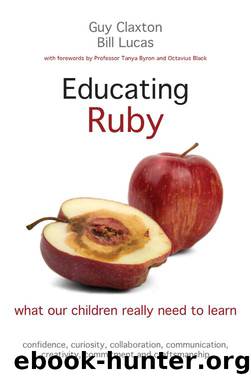Educating Ruby

Author:Guy Claxton [Guy Claxton and Bill Lucas]
Language: eng
Format: epub
ISBN: 9781845909710
Publisher: Crown House Publishing
Published: 2015-04-08T16:00:00+00:00
Age 7 to 11 – Key Stage 2: Projects driven by interest
Key Stage 2 will need to continue the apprenticeships in reading, writing and calculating, but we think that there could be two other strands. The first would involve a series of projects that are principally driven by interest in topics and questions that are intrinsically interesting to children of this age. Here’s a lovely example about the Blackawton bees:
On 22 December 2010, the prestigious science journal, Biology Letters, produced by the Royal Society, published a paper entitled ‘Colour and spatial relationships in bees’.6 The paper reports an experiment which showed that bees could use an intricate synthesis of colour and pattern information to select the most pollen-laden flowers. The paper has 30 authors, 25 of whom are 8 to 10 years old. Three are teachers, one is a researcher and the lead author, P. S. Blackawton, is the name of their school, Blackawton Primary School. The experiment was initiated, designed, conducted and written up by the children (with a small amount of help). They described their ‘principal finding’ like this: “We discovered that bumble-bees can use a combination of colour and spatial relationships in deciding which colour of flower to forage from. We also discovered that science is cool and fun because you get to do stuff that no one has ever done before.”
The researcher, Dr Beau Lotto of University College London, notes in his introduction to the published paper:
The process of science is little different from the deeply resonant, natural processes of play. Play enables us to discover and create relationships and patterns … This is science: the process that enables one to reveal previously unseen patterns of relationship … But, because the outcome of all such [enquiry] is unpredictable, supporting this ‘messyness’, which is the engine of science, is critical to good science education (and indeed creative education generally) … We have learned that doing ‘real science’ can stimulate tremendous interest in children in understanding the processes by which we make sense of the world.
Download
This site does not store any files on its server. We only index and link to content provided by other sites. Please contact the content providers to delete copyright contents if any and email us, we'll remove relevant links or contents immediately.
| Administration | Assessment |
| Educational Psychology | Experimental Methods |
| History | Language Experience Approach |
| Philosophy & Social Aspects | Reform & Policy |
| Research |
The Art of Coaching Workbook by Elena Aguilar(50887)
Trainspotting by Irvine Welsh(21496)
Twilight of the Idols With the Antichrist and Ecce Homo by Friedrich Nietzsche(18483)
Fangirl by Rainbow Rowell(9079)
Periodization Training for Sports by Tudor Bompa(8151)
Change Your Questions, Change Your Life by Marilee Adams(7619)
This Is How You Lose Her by Junot Diaz(6765)
Asking the Right Questions: A Guide to Critical Thinking by M. Neil Browne & Stuart M. Keeley(5611)
Grit by Angela Duckworth(5502)
Red Sparrow by Jason Matthews(5375)
Paper Towns by Green John(5075)
Room 212 by Kate Stewart(5020)
Ken Follett - World without end by Ken Follett(4628)
Housekeeping by Marilynne Robinson(4312)
The Sports Rules Book by Human Kinetics(4279)
Double Down (Diary of a Wimpy Kid Book 11) by Jeff Kinney(4192)
Papillon (English) by Henri Charrière(4183)
The Motorcycle Diaries by Ernesto Che Guevara(3997)
Exercise Technique Manual for Resistance Training by National Strength & Conditioning Association(3943)
